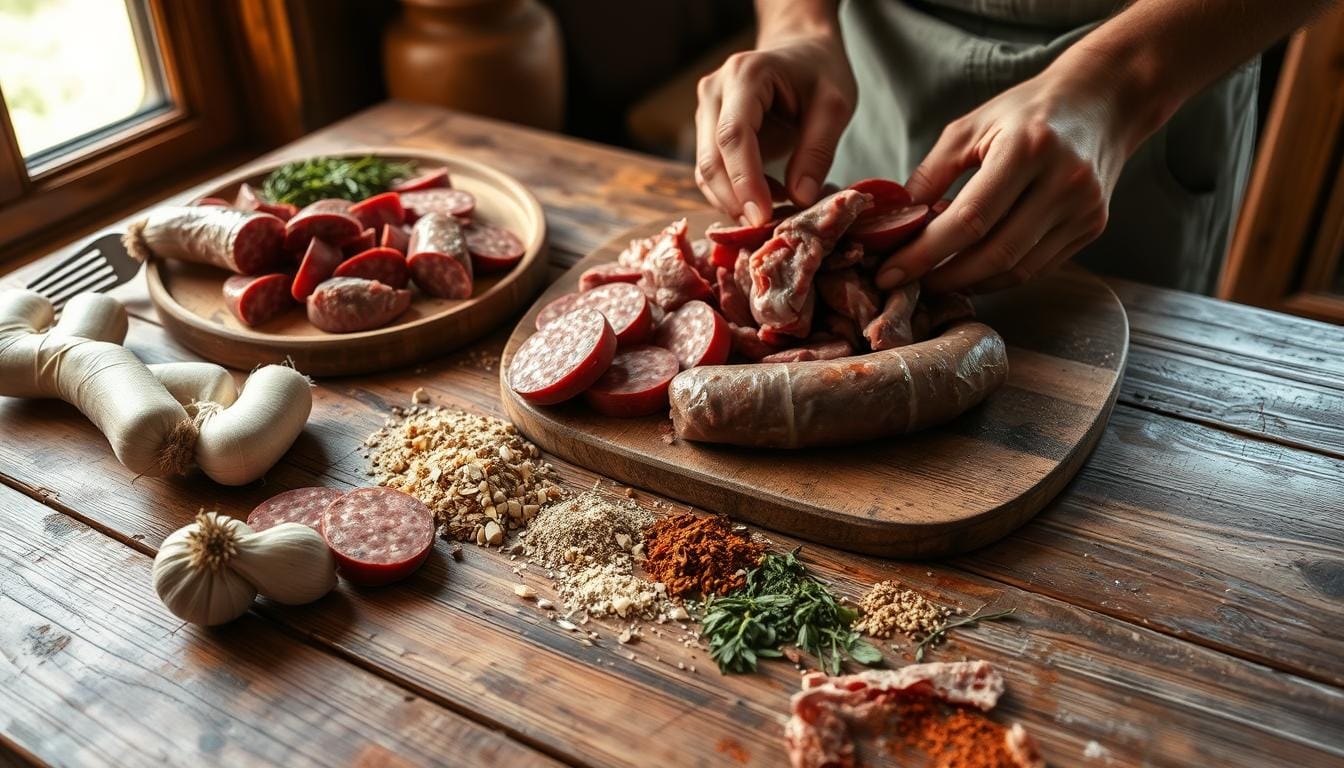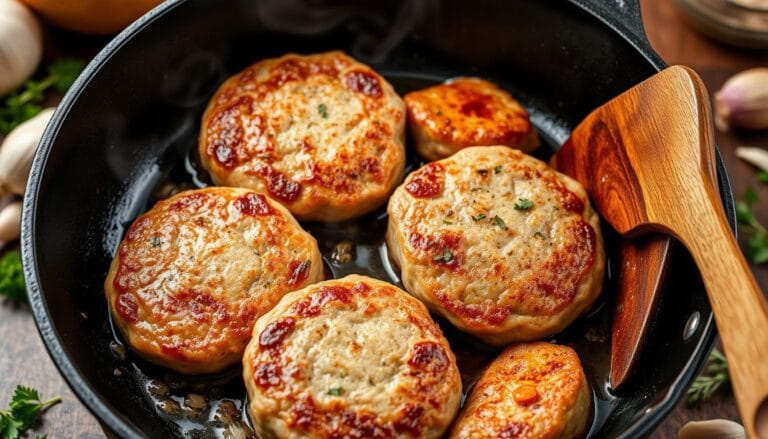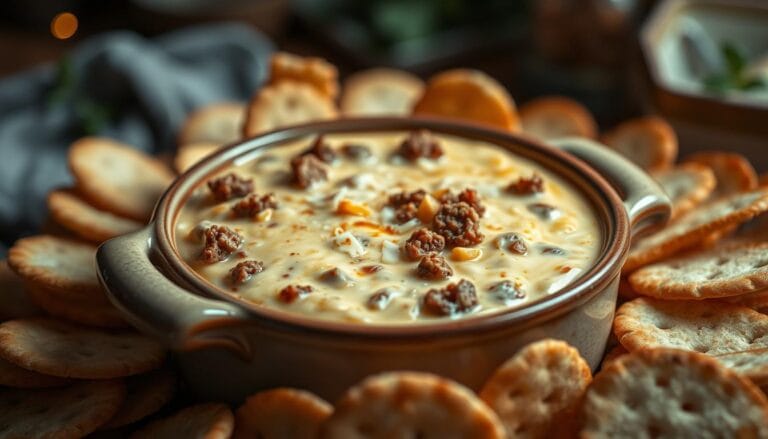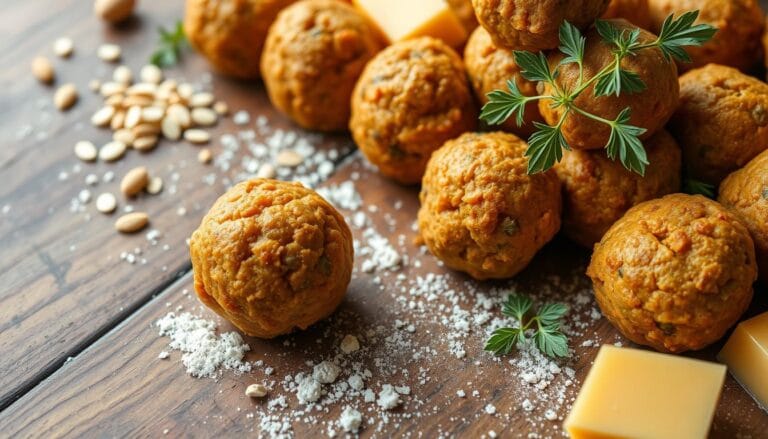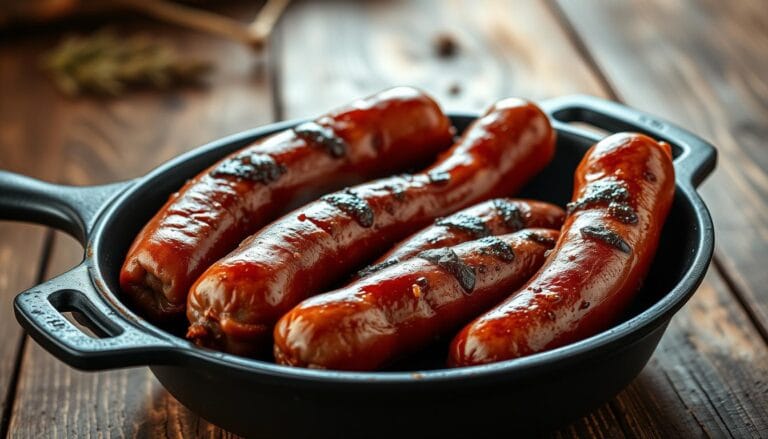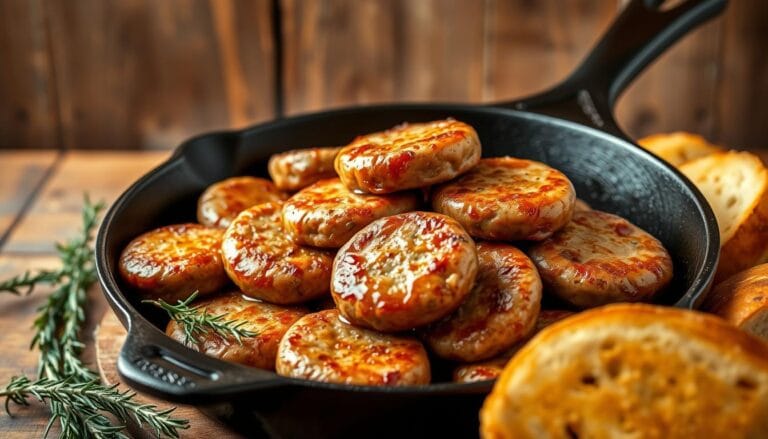How to Make the Best Deer Sausage at Home: A Step-by-Step Guide
Every hunter feels proud when they turn their hunt into a tasty meal. Making homemade deer sausage is more than a skill. It’s a tradition that connects you deeply with your food.
Venison charcuterie is more than a recipe. It’s a chance to make something special from your wild game. Whether you’re experienced or new to cooking, making deer sausage lets you control the flavor and quality.
Your homemade deer sausage recipes can change how you enjoy lean, healthy meat. With the right methods, you’ll make venison trimmings into delicious sausages. These will wow your family and friends.
This guide will show you how to make top-notch venison sausage in your kitchen. You’ll learn about choosing the best cuts, seasoning, and stuffing. You’ll turn your hunting success into a culinary masterpiece.
Table of Contents
Essential Equipment and Tools for Venison Sausage Making
Making tasty game meat sausages needs the right tools and careful prep. Whether you’re a seasoned hunter or a home cook, the right tools are key. They make a big difference in your sausage-making journey.
Wild game sausage making needs specific gear for quality and safety. Let’s look at the essential tools for turning venison into tasty sausages.
Meat Grinders: Your Primary Sausage-Making Tool
Choosing the right meat grinder is vital for making game meat sausages. Electric grinders are best for big batches of venison because they’re efficient.
- Electric grinders recommended for large volume processing
- Kitchen attachments work well for smaller batches
- Choose grinding plates carefully (medium or large recommended)
Critical Sausage-Making Accessories
There are several important accessories for making wild game sausage:
| Equipment | Purpose | Recommended Specification |
|---|---|---|
| Kitchen Scale | Measuring meat and fat ratios | Accurate to 0.1 oz |
| Meat Lugs | Mixing ground meat | Large capacity containers |
| Stuffing Horn | Filling sausage casings | Stainless steel, multiple sizes |
Storage and Packaging Considerations
Proper storage keeps your homemade game meat sausages fresh and tasty. Use:
- Fibrous casings (1 1/2″ x 12″)
- Vacuum-seal bags for long-term storage
- Cure packets for preservation
Pro tip: Always soak casings in warm water before use. This ensures smooth stuffing and the best texture for your wild game sausage.
Selecting and Preparing Your Deer Meat
Making tasty deer summer sausage begins with picking the right meat and preparing it well. The quality of your venison snack sticks depends on the meat you choose. So, it’s important to know how to pick and process your deer meat.
When picking deer meat for sausage, look for high-quality cuts. These will give your sausage the best flavor and texture. The perfect mix is:
- 80% lean game meat
- 20% pork fatback for the right moisture and taste
Keeping the meat cold is key during preparation. Work in a cold place like a freezer or a cooled area. This keeps the meat quality high and makes it safer to handle.
Different deer cuts are better for different dishes:
- Loins: Great for sautéing or grilling
- Tenderloins: A special treat for eating right away
- Hindquarters: Excellent for making sausage
Tip for your deer summer sausage: Adding 30% beef or pork trimmings can make it more moist and flavorful. Use fresh, well-handled meat for the best results in your homemade venison snack sticks.
Remember, the quality of your sausage starts with the quality of your meat selection and preparation.
Understanding Fat-to-Meat Ratios for Perfect Deer Sausage
Making artisanal venison sausage needs careful attention to fat-to-meat ratios. The right mix affects the sausage’s taste, texture, and quality. Since deer meat is lean, adding the right fat is key for a tasty and moist sausage.
For deer meat curing, follow these fat percentage guidelines for the best results:
- Sausage production: Use 20% fat to 80% venison
- Breakfast sausage: Aim for a 50/50 venison and pork mix
- Juicier applications: Increase fat content to 25%
Optimal Pork Fat Percentages
For most deer sausage recipes, a 10% fat-to-meat ratio is best. This means about 2.5 pounds of pork fat for every 22.5 pounds of venison. The fat adds moisture and flavor.
| Meat Type | Fat Percentage | Best Use |
|---|---|---|
| Venison | 90% | Lean Burgers |
| Venison + Pork | 80-20% | Traditional Sausage |
| Venison + Bacon | 85-15% | Smoky Sausage Variants |
Mixing Techniques for Proper Fat Distribution
To mix fat evenly, keep meat and fat very cold. Cut them into small, uniform pieces before grinding. Mix well but gently to avoid warming the fat too much, which can cause it to separate.
Temperature Control During Processing
Keeping temperatures low is crucial in deer meat curing. Work in a cool place, use chilled tools, and keep ingredients cold between steps. This stops bacteria growth and keeps the sausage’s texture and flavor good.
Traditional Deer Sausage Seasoning Blends
Making the perfect deer sausage is all about seasoning. You need to find the right mix of spices that make the meat taste better without being too much. With the right blend, your homemade deer sausage can go from good to great.
Choosing the best spices is crucial for amazing deer sausage. You want spices that match the lean, rich taste of venison. Traditional blends use a mix of savory and aromatic spices to add depth and complexity.
Classic Seasoning Blend Components
- Salt: Enhances natural meat flavors
- Black Pepper: Adds warmth and spice
- Dried Herbs: Marjoram, thyme, rosemary
- Garlic Powder: Provides robust flavor
- Paprika: Introduces subtle sweetness
Here’s a seasoning blend to make your venison charcuterie perfect:
| Ingredient | Quantity |
|---|---|
| Kosher Salt | 3 tablespoons |
| Black Pepper | 3 tablespoons |
| Ground Sage | 3 tablespoons |
| Paprika | 3 tablespoons |
| Cayenne Pepper | 2 teaspoons |
Don’t be afraid to try different spice levels in your deer sausage. Start with small amounts and taste as you go. The goal is to enhance the venison’s flavor, not cover it up.
“Great deer sausage is about balance, not overpowering spices.” – Wilderness Meat Crafting Guide
Step-by-Step Grinding and Mixing Process
Making wild game sausage needs precision and skill. It turns deer meat into a tasty, top-notch sausage. This sausage will wow anyone who tries it.
Primary and Secondary Grinds
First, prepare your deer meat well. Remove bones and sinew. Cut the meat into pieces that fit your grinder. Pro tip: Chill both the meat and grinder parts in the freezer before grinding to maintain optimal cold temperatures.
- Use a coarse grinding plate (#7-8) for the first grind
- Aim for chunks around 1-2 inches in size
- Consider a second grind for finer texture
Incorporating Seasonings and Binders
Choosing the right mix of meats and seasonings is key. For a standard batch, mix:
- 20 lbs deer trimmings
- 4 lbs pork trimmings
- 1 lb pork fat
Add these seasonings to your mix:
- Sea salt
- Black pepper
- Hickory smoke flavor powder
- Curing salt
- Dried jalapeño flakes
- High-temp cheddar cheese
Testing Seasoning Levels
Getting the flavor just right means testing it. Make a small test patty and cook it well. If it’s too dry, add a little cold water. Use a kitchen scale for exact amounts, mixing in 10-pound batches.
Remember: The key to great wild game sausage is maintaining cold temperatures and achieving the right meat-to-fat ratio.
Stuffing Techniques for Professional Results
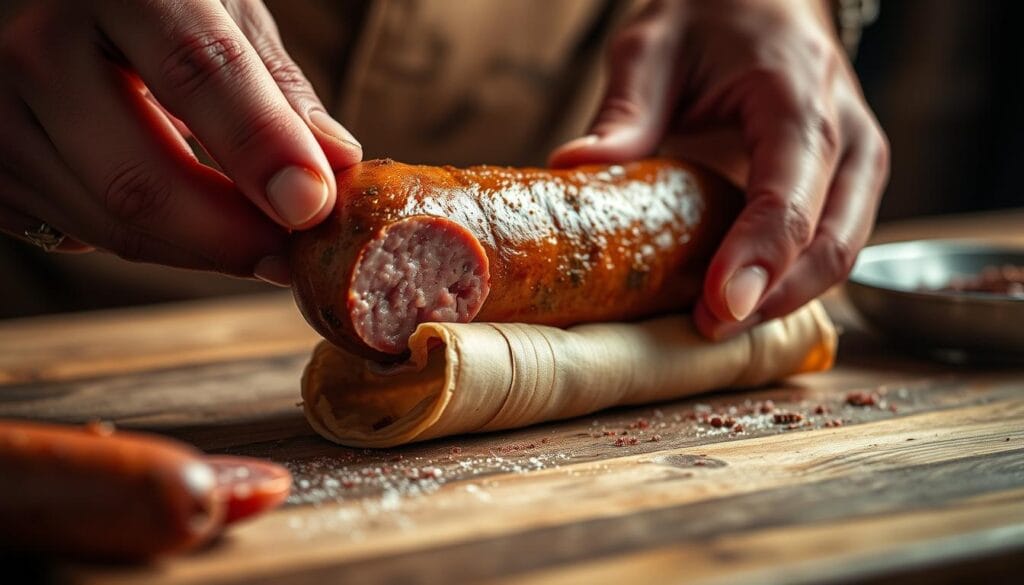
Mastering the art of stuffing deer summer sausage is all about precision and the right tools. Your venison snack sticks will only be as good as your stuffing technique. So, pay close attention to these professional tips.
When preparing to stuff your sausage, choose the right tools for success. Stainless steel stuffing horns are your best choice. They offer several advantages:
- Easy casing sliding
- Reduced risk of scratching
- Longer equipment lifespan
Choosing the correct stuffing horn is key for perfect deer summer sausage. Pick a horn slightly smaller than your casing. This prevents stretching and potential tearing.
| Casing Type | Best Used For | Characteristics |
|---|---|---|
| Natural Casings | Traditional Sausages | Made from animal intestines, ideal for smoking |
| Collagen Casings | Consistent Venison Snack Sticks | Uniform size, easy to use |
| Fibrous Casings | Dried Sausages | Allows smoke penetration |
For the best results with your venison snack sticks, practice consistent pressure when stuffing. Avoid air pockets by slowly and steadily filling the casings. This ensures a compact and professional-looking sausage.
Pro tip: Keep your meat mixture and equipment cold throughout the stuffing process. This helps maintain texture and prevents fat separation. It results in a more cohesive deer summer sausage.
Curing and Smoking Methods
Crafting the perfect deer meat curing process is an art. It turns ordinary venison into an extraordinary culinary experience. The key is mastering the balance of curing and smoking techniques.
- Pink Sodium Nitrite Curing Salt (6.25%)
- Natural Celery Powder & Cherry Powder Cure
Safe Curing Practices
Your safety is crucial when making venison sausage. Follow these guidelines for a safe and delicious product:
- Use precise measurements of curing salts
- Keep the meat refrigerated consistently
- Check the meat’s internal temperature carefully
Temperature and Time Guidelines
Smoking your venison sausage needs careful attention to temperature and time. The best smoking parameters are:
- Temperature Range: 225°F to 250°F
- Smoking Duration: 5-6 hours
- Target Internal Temperature: 160°F for safety
Wood Selection for Smoking
Choose the right wood chips to elevate your deer meat curing. Oak and hickory wood give a classic flavor that suits venison well. These woods add a rich, smoky taste that will please your taste buds.
Pro tip: Let your smoked venison sausage rest for at least 30 minutes after smoking. This helps juices redistribute and makes it more tender.
Storage and Preservation Tips
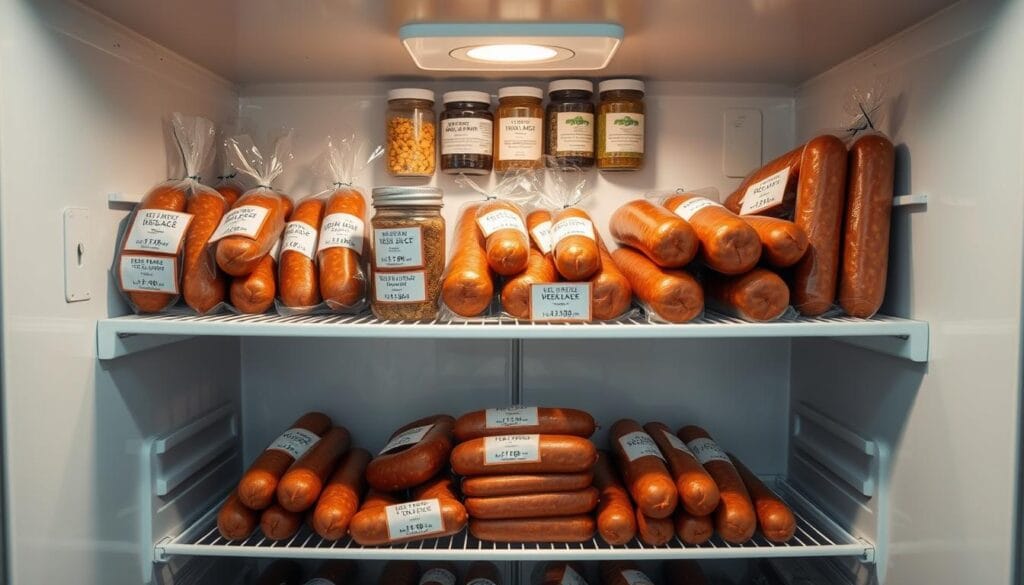
Keeping your wild game sausage fresh is key. Your homemade deer sausage recipes need careful handling. This helps keep their flavor and prevents spoilage.
There are a few ways to store your fresh wild game sausage:
- Refrigeration for short-term storage
- Freezing for extended preservation
- Vacuum sealing to prevent freezer burn
Here’s a detailed guide on how to store your homemade deer sausage:
| Sausage Type | Refrigerator Storage | Freezer Storage |
|---|---|---|
| Fresh Deer Sausage | 1-2 days | 2-3 months |
| Smoked Deer Sausage | 2-3 months | 5-6 months |
| Cured Deer Sausage | 7-14 days | 9-12 months |
Here are some important storage tips for your wild game sausage:
- Always store sausages at 0°F (-18°C) when freezing
- Keep refrigerated sausages at 40°F (4°C) or below
- Use vacuum sealing to extend shelf life up to 2 years
- Label packages with the date of storage
- Avoid thawing at room temperature
When you’re ready to enjoy your homemade deer sausage, thaw it safely in the fridge. Then, eat it within the recommended time for the best taste and quality.
Conclusion
Making deer sausage at home is more than a skill. It connects you to traditional food and hunting. Your journey turns wild game into tasty dishes that show your kitchen skills.
Every batch of deer sausage is a chance to try new flavors and recipes. Whether it’s spicy or classic, your hard work and quality ingredients will be clear in every bite.
Success in deer sausage making comes from patience, practice, and passion. Start with what you’ve learned, but feel free to try new things. Your skills will grow with each sausage, making your hunting harvest into a special meal for family and friends.
Keep improving your venison charcuterie skills, listen to feedback, and enjoy the process. Your homemade deer sausage is a sign of your skill, creativity, and commitment to sustainable cooking.
FAQ
What type of meat grinder do I need for making deer sausage?
How much pork fat should I mix with deer meat for sausage?
Is it safe to make deer sausage at home?
What are the best seasonings for venison sausage?
How long can I store homemade deer sausage?
Do I need special equipment to stuff sausage casings?
What’s the best wood for smoking deer sausage?
Can I make deer sausage without adding pork fat?
How do I prevent my deer sausage from being too dry?
What’s the best way to test seasoning before stuffing?
How Was Your Experience ?
There are no reviews yet. Be the first one to write one.
Source Links
- How to Make Deer Breakfast Sausage at Home – https://beardedbutchers.com/blogs/news/how-to-make-deer-breakfast-sausage-at-home?srsltid=AfmBOoqQ79ry019aCw7_4fwzPUMyuHzpBdbG03uGBhG_R5QqyRPTLp68
- The Best Venison Breakfast Sausage Recipe – https://wildgameandfish.com/venison-breakfast-sausage/
- How to Grind Venison at Home: A Step-By-Step Guide – https://kowalskimountain.com/how-to-grind-venison-at-home/
- Backwoods® Summer Sausage Kits – https://www.lemproducts.com/product/backwoods-summer-sausage-kits/sausage-seasoning?srsltid=AfmBOookfS8bJ6VmTnYdKr2yH5Ga7F7uq7J31vkIEqdGHqlQ2s-2GSzW
- Fresh Wild Game Sausage – https://www.themeateater.com/cook/recipes/fresh-sausage-recipe
- Mastering Your Deer Processing Order: A Comprehensive Guide | Hermann Wurst Haus – https://www.hermannwursthaus.com/mastering-your-deer-processing-order-a-comprehensive-guide/
- Fat Ratio for Ground Venison – https://texashuntingforum.com/forum/ubbthreads.php/topics/9126274/re-fat-ratio-for-ground-venison
- How to Make Deer Breakfast Sausage at Home – https://beardedbutchers.com/blogs/news/how-to-make-deer-breakfast-sausage-at-home?srsltid=AfmBOopvWymRNZ6k2QoCZcWz3i8i_3-KSS-NuIdw_jd_-kzDl1M782Br
- Venison Breakfast Sausage Recipe – https://meateatingmilitaryman.com/venison-breakfast-sausage/
- DIY Smoked Venison Sausage: A Step-by-Step Guide with The Bearded Butc – https://beardedbutchers.com/blogs/news/how-to-make-smoked-deer-sausage-at-home?srsltid=AfmBOopBdhRNslfJ4iwsFlSz4VFXKqJGsWR_TtQU0xOTvASTScCIXW4o
- Homemade Smoked Venison Sausage Recipe Step by Step – https://www.ramblingrosefarmhouse.com/smoked-venison-sausage-recipe/
- High Caliber: Basic Sausage Making | High Caliber Products – https://highcaliberproducts.com/high-caliber-basic-sausage-making/
- Italian Sausage Thanksgiving Dressing (or Stuffing!) – https://ourbestbites.com/italian-sausage-thanksgiving-dressing/
- DIY Smoked Venison Sausage: A Step-by-Step Guide with The Bearded Butc – https://beardedbutchers.com/blogs/news/how-to-make-smoked-deer-sausage-at-home?srsltid=AfmBOoqyG9leQxKqB5j1FFxlB7r3p-OHcM3Ta_xXohksJCDBNAVBD2Yl
- Unlock the Venison Flavor: Mastering the Art of Smoking Deer Meat – – https://butcherbbq.com/blogs/news/unlock-the-flavor-mastering-the-art-of-smoking-deer-meat?srsltid=AfmBOorweqfbQHxniRG6sJfAOSCWIEYOhZ1l7LjiOPgsxp5_SgHsH9Fj
- How Long Does Deer Sausage Last in the Fridge | Storage Guide – https://dianesrestaurant.com/how-long-does-deer-sausage-last-in-the-fridge/
- How Long Does Deer Sausage Last In The Fridge? | Fridge.com – https://fridge.com/blogs/news/how-long-does-deer-sausage-last-in-the-fridge?srsltid=AfmBOoozsQ1DgY-qA_dn8wo_4sGgVb-XB0xquYU4nzAe7jUGx5l248sW
- DIY Smoked Venison Sausage: A Step-by-Step Guide with The Bearded Butc – https://beardedbutchers.com/blogs/news/how-to-make-smoked-deer-sausage-at-home?srsltid=AfmBOoqG_lML-6TPn6tRcBIBgSaaWHCdZF9Mo1nE749bb3-6h_6gDUzV
- From Novice to Venison Connoisseur: My First Hunting Season Success – https://butcherbbq.com/blogs/news/from-novice-to-venison-connoisseur-my-first-hunting-season-success?srsltid=AfmBOoo5XT4dMnZdKjnl5pqgQ4XqbYHe364_OpeB6cy5DEYDit0VWjZt
- Venison Jalapeño and Cheese Summer Sausage: A ‘s Delight – – https://butcherbbq.com/blogs/news/venison-jalapeno-and-cheese-summer-sausage-a-butchers-delight?srsltid=AfmBOorM_1wB7tfQw7-Ylk7LDr6L_K3Iq0P-Z1VpPwMmSjp2wWCp8ybl

